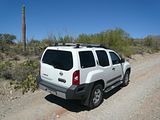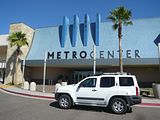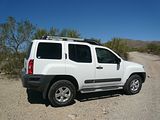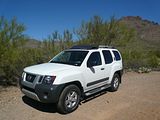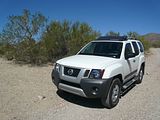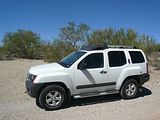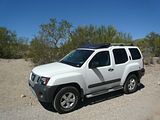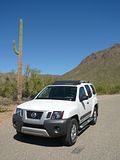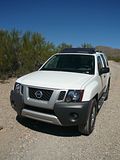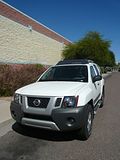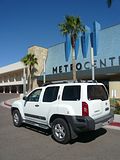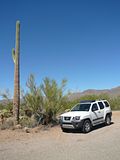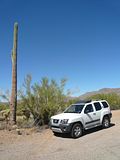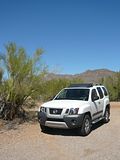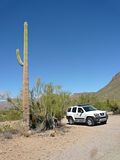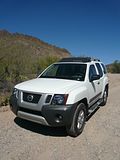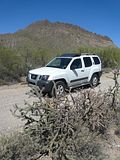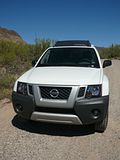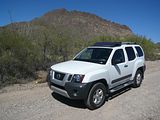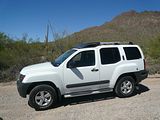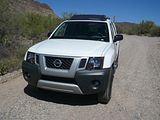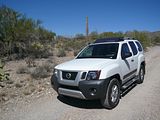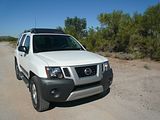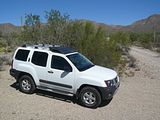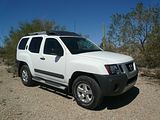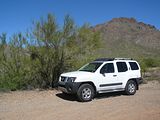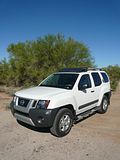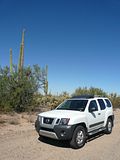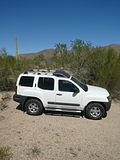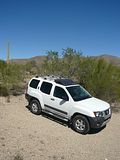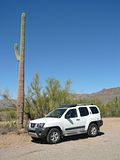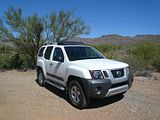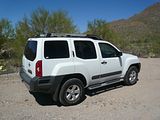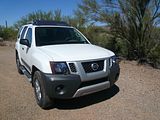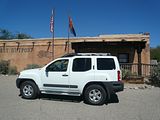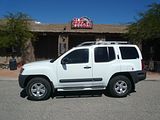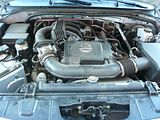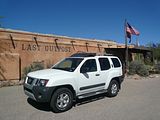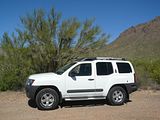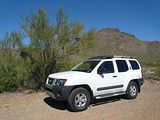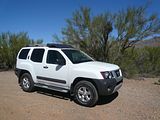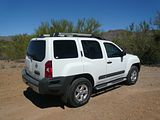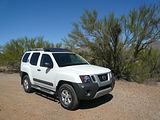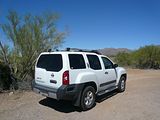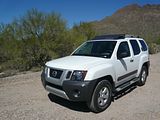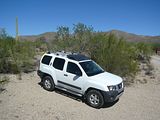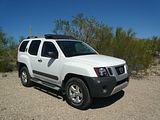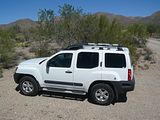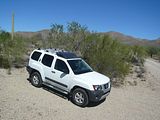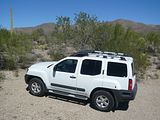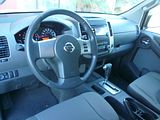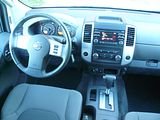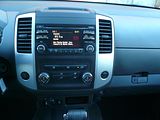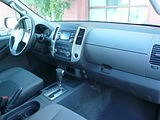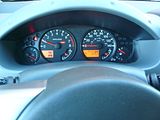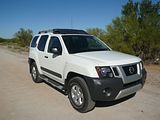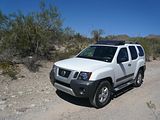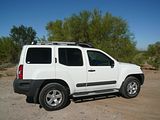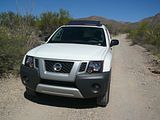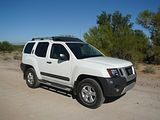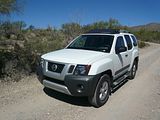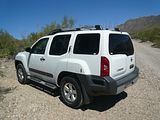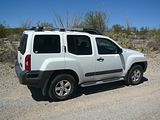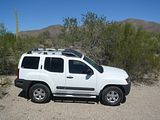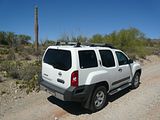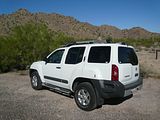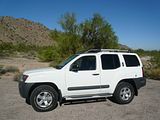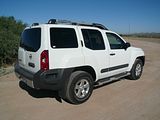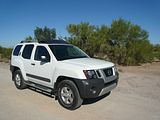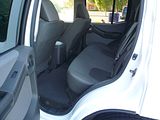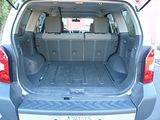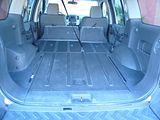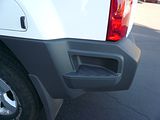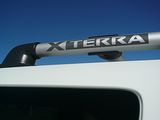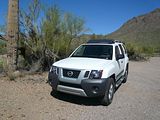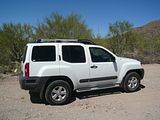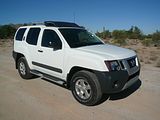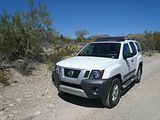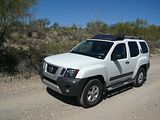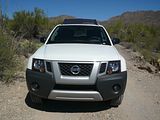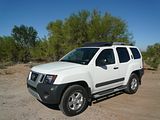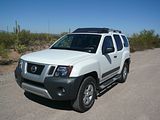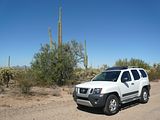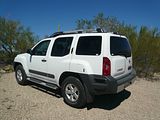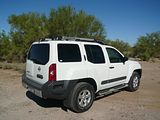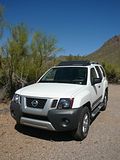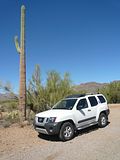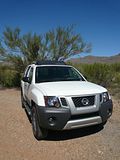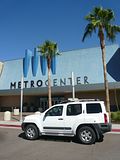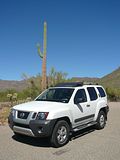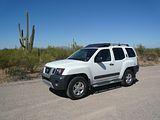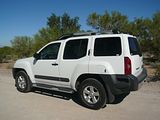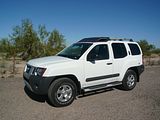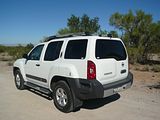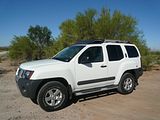Although it was not by any means the first of its genre, automotive historians will probably agree that it was Ford’s Explorer that, Firestone tyre saga notwithstanding, was probably the single vehicle most responsible for the massive increase in interest in the SUV, or so-called Sports Utility Vehicle. It did not take long for almost all major manufacturers to add their own SUV to their ranges. As early SUVs were little more than an adapted version of a pick-up, with enclosed body and more seats added, then it is no surprise that the likes of Chevrolet, Chrysler and the Japanese were so fast off the mark, as they all had suitable donor truck chassis. Nissan was among these, of course, with the Patrol already established in the market even before sales of the Explorer and its new found rivals took off. However, one size rarely fits all, and so most manufacturers quickly started to flesh out their range of SUVs just as they had done with other body styles. Combining elements of the SUV with half an eye to the established Jeep Cherokee, Nissan presented the Xterra in 1999, as a 2000 model year vehicle. A replacement design, looking very similar to the first generation model, then premiered in 2005. Manufacturers have all found that although customers like the tough appearance of the SUV, and they appreciate the extra size and height, few actually take them off road, and there are downsides to the truck-based origins, especially in terms of handling and comfort. One by one, the once sizeable number of body-on frame style SUVs have been replaced with the CrossOver, a vehicle constructed more like a car, and many of these vehicles are even offered without the pre-req of an All Wheel Drive set up. Nissan’s Pathfinder made the switch at its last redesign in 2012, meaning that the Xterra is almost the last of a dying breed. They are not that common in the Hertz fleet at present, and rumour has it that the model will probably fade away before too long, so I decided to take one for a couple of days, to see if this old school SUV is a device that you can live with on-road, or whether we are now so used to the CUV that it seems just too crude.
All Xterra models are fitted with a 4 litre V6 engine, which puts out 261 bhp. It makes a surprisingly rorty noise when you fire it up, much as you get in a Murano or the Infiniti SUVs. Once the engine had warmed up, most of the pleasant sound to the exhaust reduced and it proved to be decently muted. It is a willing unit, and this enables the Xterra driver to cope with the needs for sudden acceleration say for pulling out and overtaking on a relatively traffic-heavy freeway, which is something I had wondered about, given the rather tall and unaerodynamic look to the Nissan, and its not inconsiderable weight. The engine did prove willing at all times, making the Xterra easy to drive in traffic. The driver can choose whether to drive in rear wheel drive model only, or by twisting a dial on the lower left of the centre of the console, can select All Wheel Drive, and there is a low ratio lock feature as well. I saw no need to use AWD, so left it in RWD model throughout my test. Be in no doubt that this is a thirsty beast. When I collected it, the fuel needle was just on the wrong side of “Full”, and it dropped quite rapidly. Imagine my alarm when after just 40 miles it showed that a quarter of the tank was gone. Consumption did appear to get a little less profligate after that but not by that much, such that I was not convinced that a day trip to Tucson and back, of 250 miles was going to be possible on a single tank. Remembering that fuel is cheaper in Tucson than Phoenix, anyway, I duly filled up, so once I knew I had a genuinely full tank, I could calculate the fuel consumption brim to brim. It turned out to be 18.4 mpg US, which is just 22 mpg Imperial. Not perhaps surprising for such a vehicle, though the Nissan is nowhere near as large, say as the Escalade I had driven earlier in this trip. In a slightly primitive sort of way, the Xterra is actually quite good to drive.
The steering is appropriately weighted and has some feel about it. You do need to remember that this is a tall and quite narrow vehicle with a relatively high centre of gravity, so you cannot throw it into bends in the way that you would with a regular car or even a Cross-over and there is plenty of body roll once you do start going round corners. On well surfaced roads, the ride is not bad, but once you find ridges and cracks, then the truck origins of the chassis make themselves felt, and things become far less comfortable for the occupants. Clearly once you leave the tarmac altogether, which Nissan would expect that at least some owners would do at least some of the time, then the big wheels and tough design would come into their own, though short of venturing onto the rough stuff just far enough for photography, I did not test this out. There were no issues with the brakes, which worked well, with a nicely weighted and progressive feel to the pedal. A pull-up handbrake is fitted between the seats. With a high seating position, plenty of glass, and large door mirrors, visibility all round is good.
There is a Nissan logo on the central boss of the steering wheel, but if there was not, anyone familiar with current vehicle interiors would quickly tell you the brand that they were looking at, as not only does the Xterra conform to house style, but it uses quite a lot of componentry out of the corporate parts bin. Not that this is a Bad Thing, necessarily, as everything that is presented here feels suitably sturdy and is of decent enough quality. It is not sophisticated, but then this Nissan is not that sort of vehicle, and you have to remember that it was first released in 2005, so some of the latest, and not always welcome trends (for fussiness and a button-fest) are absent. The predominant finish to the dashboard is dark grey, with a lighter metallised type grey finish on the steering wheel spokes, around the audio unit and the gearlever. Most of the plastics are quite hard, and there is an edginess to the design which were this a passenger car, I would doubtless criticise, but in a tough practical machine like the Xterra seem almost appropriate. You get a simple, easy to use dash, with everything clearly labelled and easy to use. In the test version, the steering wheel was a moulded plastic item. There is a single instrument cowl which covers the two large dials of speedometer and rev counter. Smaller gauges for fuel level and water temperature are inset into the base of these. They are clearly marked and easy to read. Chunky twin column stalks operate the indicators and lights from the left, and wipers on the right. The centre of the dash contains the audio unit. This is a simple and relatively old tech looking unit, until you turn it on, when you discover vestiges of colour in the display. However, with not a lot to show on the screen in this version, that seems almost pointless. It did have a button on it for XM satellite radio on it, but the subscription appeared expired. In this trim level there are no repeaters for the audio unit on the steering wheel hub, just three simple and rather small switches for the cruise control. I was a little surprised to find that signal is received by an old style whippy aerial, mounted at the base of the windscreen, as these have more or less disappeared now. That said, it did a good job, as I was still getting a strong signal on a Phoenix FM station in Tucson, over 100 miles away, and usually you lose that some way away. Under that audio unit are the air conditioning controls, three rotary knobs.
The Xterra features side running boards, and these help to ease access up into the vehicle. Once installed, the driver will find that seat adjustment is all manual, with a bar under the pew for fore/aft, and a lever on the side for a series of stepped adjustments for backrest angle. There are a couple of rotary wheels to alter the angle of the front and back of the seat. Steering column adjustment goes up and down, but not in and out. Once set up for my proportions, though, I was comfortable and had that commanding view of the surrounding traffic that is one of the reasons why people like this type of vehicle.
The rear doors are surprisingly short, so access to the back seats is more constricted than you might imagine. However, once you have threaded yourself through the narrow gap, there is plenty of space, with headroom in particularly generous supply. Leg room is there in abundance, too, and the Xterra is wide enough that three adults could sit there quite comfortably. There are, however, only two rear headrests provided. Not surprisingly, given the practical nature of the Xterra, there is a sizeable boot, which is quite deep from boot to floor even to the window line. More space can be created by dropping the asymmetrically split seat backrests down, though one irritation is that the middle seat belt is suspended from the roof, and so this remains in the way with the seats down. That said, there is a very large cargo area given that this is not a really huge vehicle. There is a underfloor stowage tray as well, which sits on top of the full sized spare wheel. If that is not enough, then there are roof rails fitted as standard, and so you could put extra things on the roof. Nissan helpfully provide a step just on the rear corners, as well as the running boards, to give you access. The front part of the roof area has a cover over it, and this is hinged, so can swivel up which I guess would ease air flow up and over anything roof-mounted, and perhaps reduce noise a bit. Needless to say. I did not test this. Inside the cabin, the Xterra is well endowed with places for odds and ends. As well as good sized bi-level glove box, there are modest door bins, a tray in front of the gear lever, another shallower one on top of the dash, and a cubby under the central armrest.
With no engine choices to worry about, all the prospective Xterra owner need select is the trim. There are three on offer: X, S and Pro-4X. The first two are available with rear wheel drive, and when this is fitted, a manual transmission is an option. All Wheel Drive versions and the Pro-4X are automatic only. The X comes as standard with 16″ steel wheels, rear privacy glass, roof rack side rails, full power accessories, air-conditioning, cloth upholstery, a 60/40 split-folding rear seat, cruise control, a tilt-only steering wheel and a six-speaker CD stereo. Costing just under $2000 more, the S gets you 16″ alloy wheels, off-road tyres, a driver seat with adjustable height and lumbar, a first aid kit which clips neatly to a purpose designed recess on the boot lid, a cargo organization system that Nissan call their Easy Clean cargo area and Utili-track cargo channel system, which are posh words for a boot mat and two recessed tracks in the boot floor to which you can attach things and you also get an upgraded sound system with auxiliary audio input/USB jacks and satellite radio. Four-wheel-drive S models also get a roof rack with crossbars. The Pro-4X adds a number of off-road-ready features including an electronic locking rear differential, hill-start assist, hill-descent control, Bilstein shock absorbers, skid plates and unique 16″ alloy wheels with upgraded off-road tyres. It also has automatic headlights, foglights and roof-mounted off-road driving lights. Inside upgrades include distinctive cloth upholstery, a fold-flat front passenger seat, a leather-wrapped steering wheel, white-face gauges, an auto-dimming rearview mirror (with built-in compass), outside temperature display, a navigation system with rearview camera, Bluetooth and a nine-speaker Rockford Fosgate sound system with a six-CD changer and satellite radio (automatic transmission models only). The Pro-4X Leather package adds leather upholstery and a passenger seatback map pocket, but deletes the flat-folding front passenger seat.
Notwithstanding the rather voracious appetite for regular unleaded, there was much to like about this Nissan. More than once I found myself comparing it to the recently discontinued Jeep Liberty, since both are aimed at the same sort of market. The Jeep was generally unpleasant in so many ways, but this Nissan hit the spot far better. It is not sophisticated at all, but in terms of doing what you would expect it to do, then it does not do a bad job at all. Indeed, it struck me as having the honest sort of simplicity that is increasingly absent from most vehicles today. That said, you would have to be sure that you can live with the prodigious thirst and that you were likely to exploit the off-road capabilities often enough that the on-road dynamics would seem an acceptable corollary. For many people, I suspect that this is the wrong balance, and hence the switch to the more comfort oriented Crossover designs. But for those who do want a vehicle of this type, the Xterra has plenty to commend it. The final coup de grace is the price. On the road, an Xterra S is listed as starting from just $24,850. That makes it something of a bargain. Perhaps the better analogy is that this is the US equivalent of a larger Dacia Duster.


